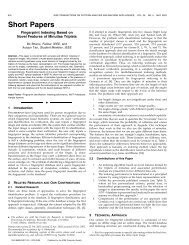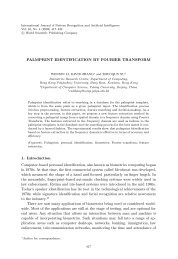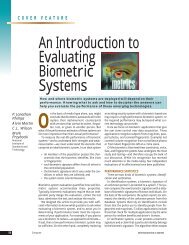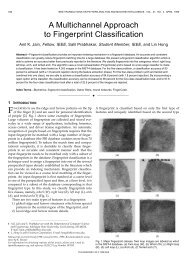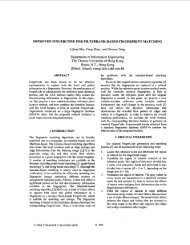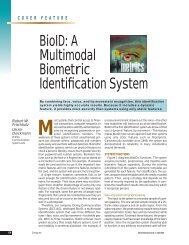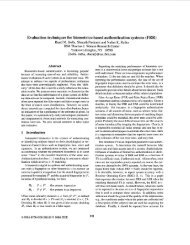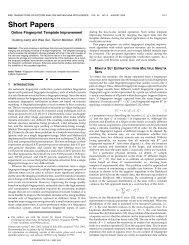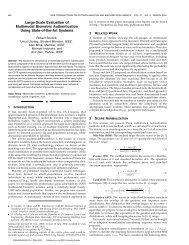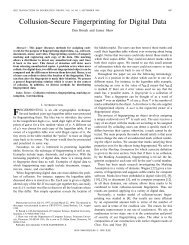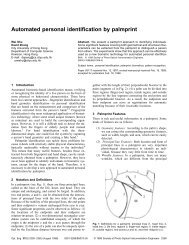Real-time embedded face recognition for smart home ... - IEEE Xplore
Real-time embedded face recognition for smart home ... - IEEE Xplore
Real-time embedded face recognition for smart home ... - IEEE Xplore
You also want an ePaper? Increase the reach of your titles
YUMPU automatically turns print PDFs into web optimized ePapers that Google loves.
186<br />
<strong>IEEE</strong> Transactions on Consumer Electronics, Vol. 51, No. 1, FEBRUARY 2005<br />
FERET <strong>face</strong> database [9], and 10 self-recorded video<br />
sequences simulating consumer <strong>home</strong> environments. We<br />
obtained an average of 92% percent detection rate. For the test<br />
on video sequences, the detector achieves approximately 0.1<br />
second/frame processing speed, with a frame resolution of<br />
320× 240 pixels, using a Pentium IV PC (1.7 GHz).<br />
detectors.<br />
Fig. 5. The geometry-based <strong>face</strong> detector, left: sliding windows <strong>for</strong> eyes<br />
and mouth; right: vertical intensity profiles of the <strong>face</strong> window.<br />
B. Geometry-based <strong>face</strong> detector<br />
In order to select potential <strong>face</strong> areas present in the skin<br />
blobs acquired in the first detector, we enumerate all small<br />
windows ( 20 × 20 pixels) extracted from each skin blob at<br />
every position and scale. This is similar to the image pyramid<br />
architecture used by Rowley et al. [8]. For each window, we<br />
apply a geometry-based <strong>face</strong> structure detector which<br />
examines the triangle-relationship between eye and mouth<br />
regions. The algorithm of the geometry-based <strong>face</strong> detector is<br />
summarized as follows.<br />
Algorithm 1: The geometry-based <strong>face</strong> verification.<br />
1. Generate the vertical profile of the candidate region<br />
(Fig. 5 right side);<br />
2. Select local minima of the profile as candidate vertical<br />
locations of eyes and mouth. If no proper minima are<br />
found, return non-<strong>face</strong>;<br />
3. For each candidate vertical location, a sliding window<br />
is applied to search horizontally <strong>for</strong> the most probable<br />
eye-pair (or mouth). The average region intensity is<br />
used as a fast evaluation criterion. If the lowest<br />
average intensity is above a threshold, return non-<strong>face</strong>;<br />
4. Check whether the selected feature group (eyes +<br />
mouth) <strong>for</strong>ms an approximate equilateral triangle. If<br />
not, return non-<strong>face</strong>.<br />
C. Learning-based detector<br />
For the final detector in the cascade, a neural-network-based<br />
(NN) detector is used. Its purpose is the final verification of<br />
facial regions and its principle is quite similar to Rowley's<br />
approach [8]. Since the previous detectors in the cascade<br />
already discard a large portion of background regions, only a<br />
small number of ambiguous candidates are passed to the NN<br />
detector. This significantly reduces the potential high<br />
computation cost of the NN detector. In the following, we<br />
provide quantitative results of our proposed <strong>face</strong> detector<br />
cascade.<br />
D. Evaluation<br />
To evaluate the per<strong>for</strong>mance of our proposed detector<br />
cascade, we use a test data set composed of color images<br />
downloaded from the Internet (most of them from Yahoo News<br />
photo gallery), randomly selected samples from the color<br />
IV. FACIAL FEATURE EXTRACTION AND FACE<br />
NORMALIZATION<br />
The outputs from the <strong>face</strong> detector (see the previous<br />
subsection) contain <strong>face</strong>s with varying scale, position and<br />
pose. The direct use of unaligned facial images will potentially<br />
lead to identification failures. To this end, we need an accurate<br />
extraction of salient facial features <strong>for</strong> normalization purposes.<br />
One earlier approach <strong>for</strong> feature extraction is proposed by<br />
Yuille et al. [10]. In this approach, parameterized de<strong>for</strong>mable<br />
templates are used to minimize a predefined fitting function.<br />
However, it is too computationally expensive <strong>for</strong> consumer<br />
use. More recently, the Active Shape Model (ASM) and<br />
Active Appearance Model (AAM) [11] were proposed as two<br />
effective techniques <strong>for</strong> feature extraction. In those techniques,<br />
a constrained statistical shape model is adopted, which offers<br />
fast and stable per<strong>for</strong>mance. However, both ASM and AAM<br />
suffer from wrong convergence when the model is not<br />
initialized sufficiently close to the real <strong>face</strong> position.<br />
We propose a two-step coarse-to-fine feature extractor [12]<br />
as shown in Fig. 3. First, we use Edge Orientation Matching<br />
(EOM) [13] <strong>for</strong> a fast determination of approximate facial<br />
feature positions within the detected <strong>face</strong> region. This ensures<br />
a ‘close’ initialization of the shape model used by the second<br />
step, alleviating the wrong convergence problem caused by<br />
improper model initializations. Second, H-ASM (an enhanced<br />
version of ASM) is adopted to iteratively fit a statistical shape<br />
model to the input image. Note that in contrast with ASM, we<br />
use 2-D Haar-wavelet-based texture attributes in H-ASM to<br />
guide the de<strong>for</strong>mation process, which facilitates increased<br />
robustness and fast processing.<br />
A. Feature estimation by EOM<br />
Since prominent facial features like eyes and mouth are<br />
often characterized by relatively pronounced edges, edge<br />
in<strong>for</strong>mation (with both strength and orientation) proved to be<br />
effective in <strong>face</strong> processing [13]. The edge map of a given<br />
image region is obtained by convolving the image with a<br />
horizontal and vertical 3× 3 Sobel edge filter. Based on the<br />
convolution results ( SX<br />
( x, y)<br />
and SY<br />
( x, y )), the Edge-Strength<br />
image ( ES ) and the Edge-Orientation image ( EO ) are<br />
generated, given by<br />
2 2<br />
ES( x, y) = SX( x, y) + SY( x, y),<br />
SY<br />
( x, y)<br />
(1)<br />
EO( x, y) = arctan .<br />
SX<br />
( x, y)<br />
Using the average ES and EO as a template, a multiresolution<br />
search is per<strong>for</strong>med over the detected facial region<br />
<strong>for</strong> the position and scale yielding the best match (Fig. 6). The



